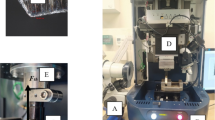Abstract
Purpose
Robotic total hip arthroplasty is a procedure in which milling operations are performed on the femur to remove material for the insertion of a prosthetic implant. The robot performs the milling operation by following a sequential list of tool motions, also known as a toolpath, generated by a computer-aided manufacturing (CAM) software. The purpose of this paper is to explain a new toolpath force prediction algorithm that predicts cutting forces, which results in improving the quality and safety of surgical systems.
Methods
With a custom macro developed in the CAM system’s native application programming interface, cutting contact patch volume was extracted from CAM simulations. A time domain cutting force model was then developed through the use of a cutting force prediction algorithm. The second portion validated the algorithm by machining a hip canal in simulated bone using a CNC machine. Average cutting forces were measured during machining using a dynamometer and compared to the values predicted from CAM simulation data using the proposed method.
Results
The results showed the predicted forces matched the measured forces in both magnitude and overall pattern shape. However, due to inconsistent motion control, the time duration of the forces was slightly distorted. Nevertheless, the algorithm effectively predicted the forces throughout an entire hip canal procedure.
Conclusion
This method provides a fast and easy technique for predicting cutting forces during orthopedic milling by utilizing data within a CAM software.









Similar content being viewed by others
References
Paul HA, Bargar WL, Mittestadt B, Musits B, Taylor R, Kazanzides P, Zuharas J, Williamson B, Hanson W (1992) Development of a surgical robot for cementless total hip arthroplasty. Clin Orthop Relat Res 285:57–66
Denis K, Van Ham G, Vander Sloten J, Van Audekercke R, Van Der Perre G, De Schutter J, Kruth J-P, Bellemans J, Fabry G (2001) Influence of bone milling parameters on the temperature rise, milling forces and surface flatness in view of robot–assisted total knee arthroplasty. Int Congr Ser 1230:300–306
Plaskos C (2003) Modelling and optimization of bone-cutting forces in orthopaedic surgery. Med Imaging Comput Comput Assist Interv 2878:254–261
Plaskos P, Cinquin A, Hodgson, Lavallée S (2005) Safety and accuracy considerations in developing a small sterilizable robot for orthopaedic surgery. In: IEEE conference on robototics and automation, pp 942–947
Layegh S, Erdim H, Lazoglu I (2012) Offline force control and feedrate scheduling for complex free form surfaces in 5-axis milling. Proced CIRP 1.1:96–101
Lundskog J (1972) Heat and bone tissue. An experimental investigation of the thermal properties of bone tissue and threshold levels for thermal injury. Scand J Plast Reconstr Surger Suppl 9:1–80
Sugita N, Mitsuishi M (2009) Specifications for machining the bovine cortical bone in relation to its microstructure. J Biomech 42(16):2826–2829
Naohiko S, Yoshikazu N, Mamoru M (2008) Dynamic controlled milling process in bone cutting machine for orthopedic surgery. Trans Soc Instrum Control Eng 44.4:377–383
Kazanzides P, Zuhars J, Mittelstadt B, Taylor, Rusell H (1992) Force sensing and control for a surgical robot. In: IEEE international conference on robotics and automation
Tunc L, Budak E (2009) Extraction of 5-axis milling conditions from CAM data for process simulation. Int J Adv Manuf Technol 43(5–6):538–550
Altintas Y (2000) Manufacturing automation: metal cutting mechanics, machine tool vibrations, and CNC design. Cambridge University Press, Cambridge
BoneSim—products and properties. BoneSim Laboratories. http://www.bonesim.com/products_and_properties
Budak E, Altintas Y, Armarego EJA (1996) Prediction of milling force coefficients from orthogonal cutting data. J Manuf Sci Eng 118:216–224
Inoue T, Kuramoto K, Nakashima Y, Sugita N, Mitsuishi M, Nakashima Y (2011) Surgical assistance system National University Corporation Tokyo University, Assignee. Patent 0306985
Acknowledgments
The authors express their appreciation to MTTRF and THINK Surgical, Inc., for lending their equipment and useful discussions. Support and funding for this work were provided by THINK Surgical, Inc.
Author information
Authors and Affiliations
Corresponding author
Ethics declarations
Conflict of interest
The authors declare they have no conflict of interest.
Ethical standard
This article does not contain any studies with human participants or animals performed by any of the authors.
Informed consent
This article does not contain patient data.
Rights and permissions
About this article
Cite this article
Kianmajd, B., Carter, D. & Soshi, M. A novel toolpath force prediction algorithm using CAM volumetric data for optimizing robotic arthroplasty. Int J CARS 11, 1871–1880 (2016). https://doi.org/10.1007/s11548-016-1355-x
Received:
Accepted:
Published:
Issue Date:
DOI: https://doi.org/10.1007/s11548-016-1355-x





